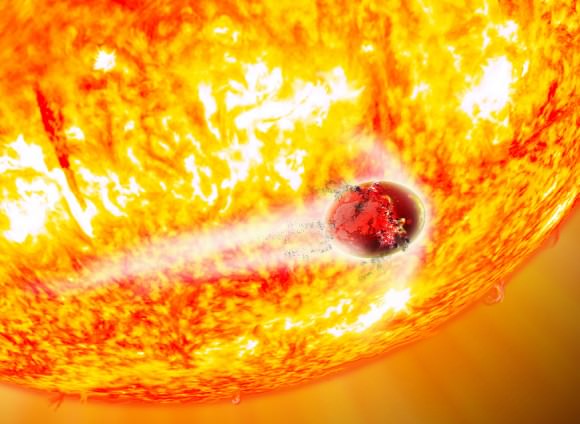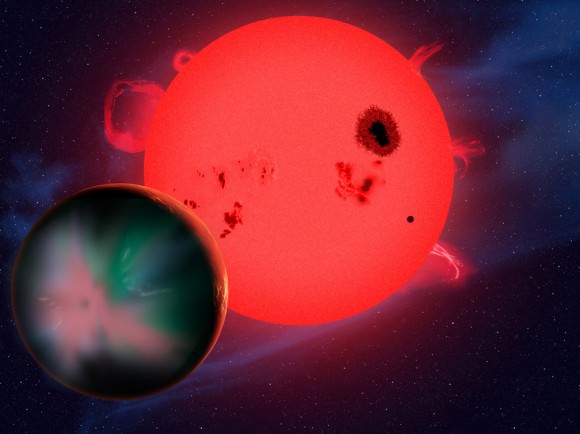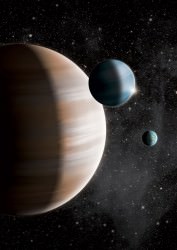Can you imagine a world that is 17 times as massive as Earth, but still rocky? Or two planets that are doomed to be swallowed up by their parent star in just a blink of astronomical time?
While these scenarios sound like science fiction, these are real-life finds released today (June 2) at the American Astronomical Association meeting in Boston.
Here’s a rundown of the finds about these planets in our ever-more-amazing universe.
‘Mega-Earth’ Kepler-10c
Spinning around its star every 45 days is Kepler-10c, which is about 2.3 times as large as Earth but a heavyweight, at 17 times more massive. The planet was discovered by the prolific NASA Kepler space telescope (which was sidelined after a reaction wheel failed last year, but now has been tasked with a new planet-hunting mandate.)
While initially astronomers thought Kepler-10c was a “mini-Neptune”, or a world that is similar to that planet in our solar system, its mass measured by the HARPS-North instrument on the Galileo National Telescope showed it was a rocky world. What’s more, astronomers believe the planet did not “let go” of any atmosphere over time, which implies the planet’s past is similar to what it was today.
Here’s the other neat thing: astronomers found that the system was 11 billion years old, at a time when the universe was young (it was formed 13.7 billion years ago) and the elements needed to make rocky planets were scarce. This implies that rocky planets could have formed earlier than previously thought.
“I was wrong that old stars do not have rocky planets, which has consequences about the Fermi Paradox,” the Harvard-Smithsonian Center for Astrophysics’s (CfA) Dimitar Sasselov said in a webcast press conference today (June 2). The Fermi Paradox, simply put, refers to the question of why we can’t see civilizations since they are assumed to have spread quite a ways since the universe was formed.

‘We’re doomed!’ Kepler-56b and Kepler-56c
If there was anybody in the vicinity of these two planets, you’d want to move out of the way fairly quickly — at least when talking about astronomical time. Both of these planets, whose orbits are within the equivalent distance of Mercury to the sun, are expected to be swallowed up by their star in 130 million years (for Kepler-56b) and 155 million years (Kepler-56c). It’s the first time two doomed planets have been found in a single system.
“Possibly the core of planet will be left behind and you [will] see this dead corpse floating behind in the universe,” said CfA’s Gongjie Li in the press conference.
There are two factors behind this: the size of the star will enlarge as it gets older (which is typical among stars) and the tidal forces between the planets and their star will also cause them to slow down in their orbits and rip apart. Interestingly enough, another gas giant planet called Kepler-56d will remain safe from most of the chaos since its orbit is equivalent to the asteroid belt in our own solar system.
“Looking at this system is like foreseeing our own solar system,” added Li, referring to the fact that in another five billion years or so our sun will enlarge and swallow Mercury and Venus at the least, boiling off all the oceans on our planet and killing anything left.

Windy City: Why living near a red dwarf might be a bad idea
One fertile ground for exoplanet discoveries — particularly when looking for planets about Earth’s size in the habitable zone — is red dwarfs, because they are smaller and therefore have less light to obscure any rocky worlds orbiting nearby. A new study warns that they could be less friendly to life than previously believed.
CfA’s Ofer Cohen said that red dwarfs can have intense stellar winds, when looking at the model of a known red dwarf with three planets around it: KOI 1422.02, KOI 2626.01, KOI 584.01. Even a magnetic field the size of Earth would not be able to protect the planet from being stripped of its atmosphere assuming a certain intensity of stellar flares.
A member of the audience pointed out that the red dwarf star under study likely has stronger winds than 95% of all red dwarfs, however. Cohen acknowledged that, but added “the main effect is not the stellar activity, but these giants are close to the star.” All the same, this could require a more nuanced understanding of the habitable zone around these stars, he added.

Heavy metal: Figuring out how much planets have
In astronomical terms, any elements heavier than hydrogen and helium are considered to be “metallic”. Past research found that metal-rich stars tend to have hot Jupiter exoplanets, while the smaller planets have a larger span of metal possibilities.
A team led by CfA’s Lars Buchhave surveyed more than 400 stars with 600 exoplanets, and found that planets smaller than 1.7 times the size of Earth are more likely to be rocky, while those than are 3.9 times the size of Earth or larger are likely gassy.
In between is a zone called “gas dwarfs”, which are planets 1.7 and 3.9 times the size of Earth that likely have hydrogen and helium atmospheres blanketing their surface.
Also intriguing: the researchers discovered that planets far away from their stars can get larger before picking up a lot of gas and becoming a “gas dwarf”, presumably because there isn’t as much gas material out there.
The team also discovered that stars with smaller, Earth-like worlds metallicities like our sun, while stars with “gas dwarfs” have more metals, and stars with gas giants have even more metals. But bear in mind these are for planets close to their host star, which are easiest for Kepler to find. Buchhave plans to do work for planets further away.
The papers for these findings are on arVix: Kepler 10b, habitable planets orbiting M-dwarfs, exoplanets around metal-rich stars.


Every day our understanding of what is out there gets intriguingly better, we must continue to fund projects like the James Webb and push for an L2 station to increase our understanding of nearby exoplanet systems – even if some of them would have me weighing 680 lbs (310Kg) on their surface urgh!
For anyone who is more interested, the extrasolar planetary encyclopedia is a great resource. You can filter and download data to your own spreadsheet, create graphs work out which are our nearest neighbours etc. http://exoplanet.eu/
I wonder if anyone has calculated the escape velocity from one of these super earths? imagine the speed that a meteorite would strike one of these rocky worlds?
Calculating the escape velocity is very easy:
http://en.wikipedia.org/wiki/Escape_
Just the Mass of the object and the distance from its centre.
The distance from its centre could be the surface distance from the centre.